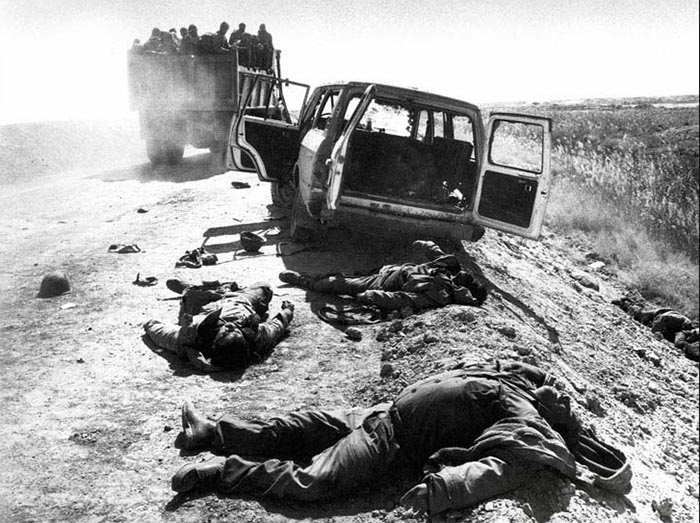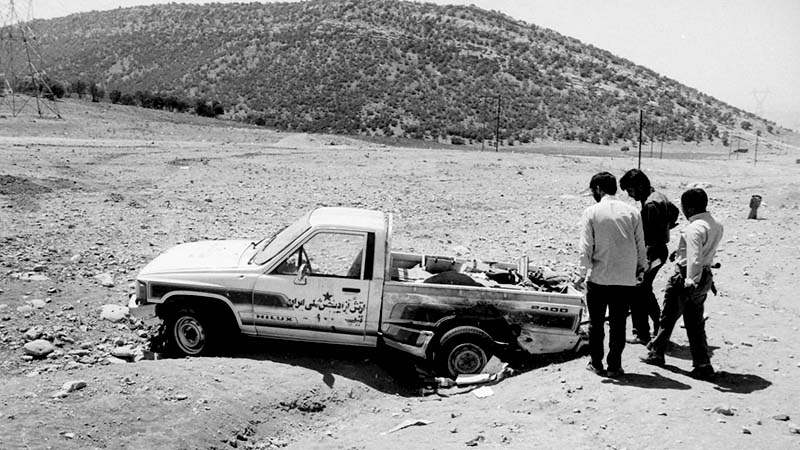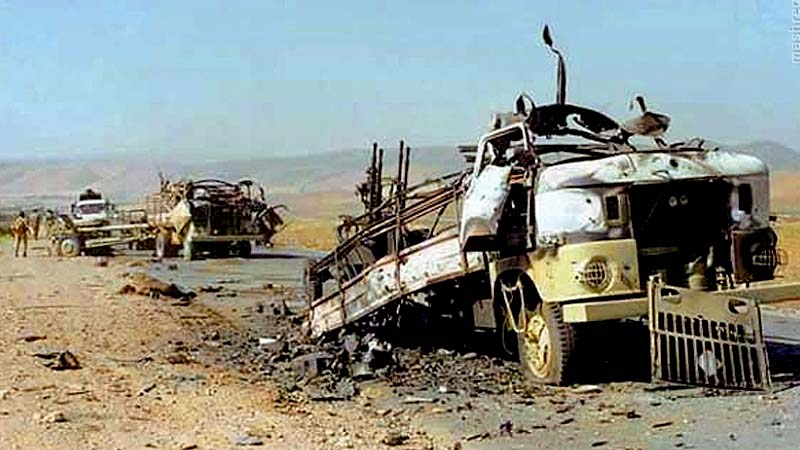The summer of 1988 witnessed a dramatic clash between Iran and the Mujahedin-e Khalq (aka MEK, MKO, PMOI) terrorist group. In the wake of an eight-year war with Iraq, Iran faced a renewed threat on its western borders. The MEK launched an offensive codenamed Operation Forough-e Javidan (Eternal Light), aiming for a swift overthrow of the Iranian government. Their gamble, however, met with a fierce Iranian response – Operation Mersad, conducted on July 27, 1988.
With Iran’s acceptance of UN Resolution 598, the illusion that had sustained the MEK began to crumble. Threatened by the prospect of an end to the war, they launched a desperate propaganda campaign. Painting Iran’s acceptance of the resolution as a sign of weakness, they plunged headlong into a dangerous fantasy: the invasion of Iran.
On July 25, 1988, fueled by delusion and bolstered by the support of Iraq’s Ba’athist regime, the MEK’s Liberation Army set out from their Iraqi bases. At 4 pm, they crossed the Khosravi border, marking the beginning of Operation Eternal Light. Their plan envisioned reaching Tehran within 48 hours, maintaining a minimum speed of 70 kilometers per hour (1).
In their delusion, they aimed to traverse the cities of Sarpol-e Zahab, Islamabad, Hamadan, and Qazvin in five stages within 33 hours to reach Tehran. The Iraqi government supported them with substantial military aid, including 120 tanks, 400 armored personnel carriers, 90 (80mm) mortars, 30 (122mm) cannons, 150 (400mm) mortars, 1000 Kalashnikov assault rifles, 30 (106mm) cannons, and 1000 trucks and vehicles.
As the MEK launched their ground invasion, a coordinated aerial assault unfolded. Iraqi jets and helicopters pounded Iranian airbases like Hamedan’s Shahid Nojeh, Dezful, Havanirooz 1st Combat Base in Kermanshah, and Saqqez 2nd Brigade Base (2).
A number of battalions employing 130-mm Field Artillery lined up west of Sarpol-e Zahab, raining fire down on Iranian positions guarding the Patagh Pass, clearing the way for the MEK’s advance. Iraqi aircraft also took out communication towers in Kerend, further isolating the Iranian forces. Attack helicopters hovered over the MEK’s frontline, spewing fire at Iranian troops and tanks stationed at the pass.
With MEK’s rapid advance, the Gilan-e Gharb border region became a scene of mass killings. In Islamabad, the MEK stormed and destroyed government buildings, unleashing a wave of terror in a grotesque attempt to win over the population (3).
Fierce clashes with civilians
While the MEK encountered minimal resistance on the southern fronts due to a stronger Iranian presence elsewhere, their dreams of a jubilant welcome in Kerend were dashed. Instead of open arms, they were met with fierce defiance. Gendarmerie forces, Revolutionary Guards, and even civilians banded together at the city’s entrance, putting up a valiant fight against them. The clash triggered a mass exodus. Families fled, seeking refuge in Islamabad or the surrounding mountains. By nightfall, Kerend stood eerily empty, a town surrendered to the MEK.
One brigade remained to secure the city, while the others, fixated on the “advance with maximum speed” strategy, pressed onward to Islamabad. Here too, the MEK encountered pockets of resistance. Local forces and government centers engaged in scattered clashes that stretched into the night. Meanwhile, the city’s residents poured towards Kermanshah, clogging the Islamabad-Kermanshah road with panicked families. The Hassan Abad Pass and Chahar Zebar Gorge were sealed shut.
Driven by their delusional belief in “popular support,” several MEK columns sped towards Kermanshah after capturing Islamabad. However, their momentum was halted before reaching Chahar Zebar Gorge by the very “support” they craved – the heavy traffic of fleeing civilians. The illusion shattered, the MEK vanguard faced its first real challenge. Their lead Jeep was ripped apart by an RPG, sparking a battle around the Hassan Abad Pass and Chahar Zebar Gorge. Despite heavy casualties on both sides, nightfall brought no victory. The following day (Day 2) saw renewed clashes, with the MEK commanders ordering desperate attacks. Each attempt, however, proved futile, leaving behind a trail of carnage and dwindling resources.
The MEK’s heavy losses
The MEK’s “advance with maximum speed” strategy unraveled within hours. The geographical conditions of the region, coupled with the effective tactics and deployment of Iranian forces (both the army and Revolutionary Guards), left the MEK floundering. Their offensive stalled, unable to attack, defend, or even maneuver effectively.
This vulnerability became increasingly glaring as time went on. Panic gripped the MEK ranks, particularly those recruited from outside Iran. These individuals, lured by political promises, had never experienced the horrors of war – the deafening roar of weapons, and the rain of bullets. Now, they found themselves thrust into the heart of a brutal conflict. Many were cut down in the opening moments, easy targets due to their lack of training and battlefield awareness. Their unfamiliarity with basic weaponry like the Kalashnikov left them unprepared for close-quarter combat. According to eyewitnesses, they peeked from trenches, offering themselves up as easy targets due to their inexperience.
The MEK leadership’s decision to promote inexperienced female commanders for political gain further compounded these problems. Many of these women lacked battlefield expertise, having served previously in logistical or political roles. Thrust into the role of tactical commanders, their inexperience proved deadly.
Continuous attacks from the Iranian Air Force and helicopters pounded the MEK forces. Helicopter-borne assaults from the surrounding hills inflicted further damage. Any attempt at movement became suicidal. The MEK found themselves desperately clinging to their positions, communication with command centers severed. Casualties mounted rapidly – commanders killed, wounded, or forced to retreat. The once-confident MEK offensive lay in tatters. Senior commanders pleaded with their leader for increased Iraqi air support. Mahboubeh Jamshidi (alias Azar), commander of the vanguard forces, even requested a chemical attack. However, Saddam Hussein’s attention had shifted. The botched Iraqi offensive on Ahvaz demanded his focus, leaving the MEK largely on their own. While Iraqi jets had initially participated in Operation Eternal Light, their presence dwindled by the second day. A lone helicopter, shot down by Iranian anti-aircraft near Kerend, showed this waning support.
By day three, the southern fronts had consumed all Iraqi air resources. No further support materialized, save for a few helicopters used to evacuate casualties. Faced with mounting losses – over 1,500 dead in just three days, according to the MEK’s own records – Rajavi was forced to make a desperate choice. Orders crackled through radios and walkie-talkies: retreat. It was a desperate scramble for survival. The MEK’s casualty list, while claiming only 1,500 dead, hinted at a far more devastating reality. More were wounded or missing. Only a meager 30 managed to escape back to Iraq. According to an MEK intelligence report, the remaining forces were scattered – killed or captured in clashes across the mountainous regions around Kerend, Islamabad, and other nearby cities. Iranian sources, citing available documents, estimated the MEK’s losses to be even higher – exceeding 2,500. Operation Eternal Light, a gamble that backfired spectacularly, marked the end of the MEK’s military ambitions.
References
1- Samad Nazari, The Devil’s Footprint, Nejat Association Publications, Tehran, 2011, p. 152
2- Reza Bastani, The Role of the Mujahedin Khalq Organization in the Iran-Iraq War, Negin Quarterly, No. 3, Winter 2002
3- Sabbar Fallah Al-Lami, Occupation and Medal, translated by Mohammad Nabi Ebrahimi, Tehran: Soroeh Mehr Publications, 2007, p. 22




